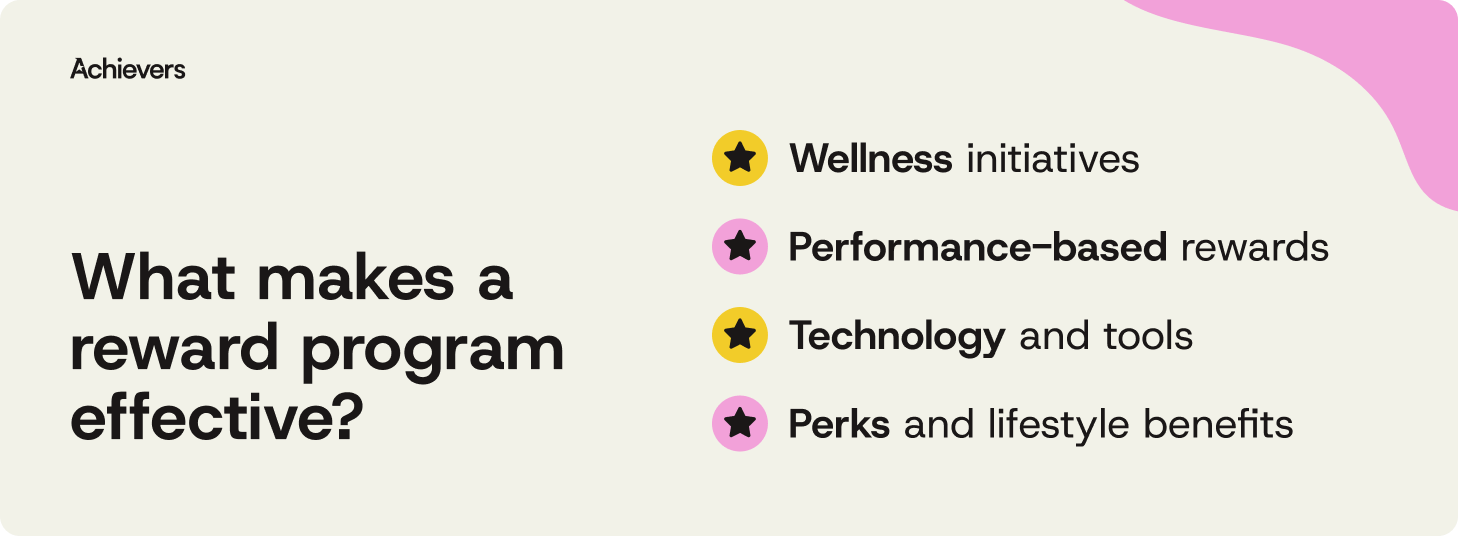Table of contents
Create a culture that means business™
Schedule a demo with an Achievers solution expert today.
Rewards and benefits often get tossed into the same bucket — think pensions, holiday pay, and the occasional course on time management.
But while both show your people that you value them, they’re not quite the same (despite what many job listings would have you believe). Benefits are the baseline — the essentials that employees expect. Rewards, on the other hand, are your secret sauce. They’re designed to celebrate great work, spark motivation, and build a culture of appreciation.
Read on to see why a thoughtful employee rewards program isn’t just a nice-to-have — it’s a game-changer for your business.
The evolving nature of employee expectations in the U.K.
Lately, there’s been a noticeable shift in what employees value most — wellness, work-life balance, and support that actually feels personal are climbing to the top of the list. According to the CIPD’s Health and Wellbeing at Work report, more than three-quarters of organizations have seen presenteeism — employees working while unwell — and nearly two-thirds have spotted ‘leaveism’, where people dip into their time off just to keep up or recover from illness. Not exactly a recipe for thriving.
On the brighter side, research from Deloitte shows that for every £1 invested in mental health and well-being, employers saw an average return of £4.70 in productivity. That’s not just encouraging — it’s compelling.
It’s clear that a one-size-fits-all benefits package doesn’t cut it anymore. A holistic rewards program helps organizations keep pace with what today’s workforce actually needs. The result? Employees feel genuinely supported — and when that happens, engagement, motivation, and loyalty tend to follow close behind.
Understanding rewards vs. benefits: the key differences
Benefits are the baked-in perks of full-time work — kind of like how making dinner guarantees you’ll eat. Rewards, though, are what inspire you to break out the good ingredients. They’re the gravy on top, the “this is amazing” from your dinner guests — that extra dose of motivation and satisfaction.
Let’s dig into what sets rewards and benefits apart — and how to build a total rewards program that actually makes a difference.
What are rewards?
Rewards are essentially acts of praise and appreciation, used to motivate employees through positive reinforcement. The types of rewards can vary depending on company culture and employee preferences, and can include recognition, employee wellness initiatives, incentives, or lifestyle perks. Here’s a breakdown of each:
- Recognition: Acknowledging an employee’s efforts, achievements, or milestones in a meaningful way.
- Wellness programs: Initiatives designed to support the overall health and well-being of employees.
- Incentives: Tangible rewards given for meeting specific goals or performance targets.
- Perks: Additional benefits that enhance the employee experience, often beyond traditional compensation.
Whatever form they take, the most impactful rewards are personal, intentional, and aligned with what your employees genuinely care about.
What are benefits?
Benefits are the essentials — things like statutory leave, workplace pensions, and National Insurance contributions that come standard with most full-time roles. Some are legally required, others are offered at your discretion. Here are a few common examples:
- Sick pay (SSP): Provided to eligible employees who are unable to work due to illness.
- Maternity/paternity leave: Paid leave available to eligible employees taking time off for maternity, paternity, or shared parental responsibilities.
- Paid annual leave: Provided to eligible employees as a minimum of 28 days of paid time off per year, including public holidays.
Then there are the extras — like life insurance or private healthcare — often offered through private schemes. Not required but definitely appreciated.
The risks of merging rewards with traditional benefits
Rewards and benefits might seem like two sides of the same coin but lumping them together can water down the value of both. Benefits are the basics — the steady, expected parts of the job that provide security and support. Rewards, meanwhile, are there to inspire — to recognize effort, fuel motivation, and celebrate wins. Mix the two, and it becomes harder for employees to tell what’s earned versus what’s just part of the package. The result? Neither lands as powerfully as it should.
Keeping them distinct helps each do its job: benefits build stability, rewards build momentum.
In the UK, many benefits platforms used for recognition are, frankly, doing the bare minimum. Recognition often feels transactional, feedback is hit-or-miss, and performance incentives are an afterthought. That means companies miss the chance to strengthen culture, boost employee engagement, and keep their best people on board.
Why rewards should be a standalone program
Rewards work best when they’re not tucked into the same drawer as traditional benefits. A standalone, thoughtfully designed rewards program ensures employees feel seen and appreciated — regularly, not just once in a blue moon. It’s also one of the most cost-effective ways to get real impact from recognition.
High-quality rewards platforms (like Achievers, for example) are built to be flexible, personalized, and responsive. They adapt based on who’s being recognized, why, and in what context — not just a one-size-fits-none approach. Here’s what that can look like:
- Personalized recognition: Tailoring rewards to each employee’s unique preferences adds meaning and relevance. When the “thank you” speaks their language, it lands better.
- Performance-based incentives: Rewarding employees based on actual contributions — instead of handing out the same perk to everyone — makes recognition feel earned and motivating.
- Culture building: A rewards program that evolves with your people shows that your culture isn’t stuck in the past. It grows, flexes, and adapts as your team does.
Keeping rewards separate from benefits gives you sharper tools to drive engagement — and it shows employees you’re not just checking boxes, you’re genuinely invested in their success
Key components of an effective rewards program
Let’s be honest — no one gets excited about the same cookie-cutter reward every time, especially after going above and beyond. To really make an impact, a rewards program needs to be well-rounded, easy to use, and built to handle a variety of meaningful recognition moments.
Here’s a closer look at the types of rewards that can take your program from “meh” to memorable — and how to weave them in.

Wellness initiatives
Wellness isn’t a “nice-to-have” anymore — it’s a must. And for good reason: globally, depression and anxiety cost businesses an estimated 12 billion working days a year. That’s a lot of burnout. A rewards program that includes wellness support shows your people you’re invested in their health, not just their output. Consider offering:
- Mental health support: Therapy sessions or mental health apps employees can actually use.
- Fitness memberships: Subsidized gym passes or online fitness subscriptions.
- Stress-relief programs: Think guided meditation, yoga classes, or the magical “wellness day off.”
It’s not just good for people — it’s good business.
Perks and lifestyle offerings
Hybrid work is here to stay, and so is the need for perks that help employees balance work and life without losing their minds. Some popular (and practical) options include:
- Flexible working hours: Because life doesn’t only happen outside 9 to 5.
- Gym memberships: Encouraging movement, whether it’s treadmill sprints or downward dogs.
- Employee discounts: Everyday savings on everything from laptops to luggage.
These perks help create a healthier, more sustainable rhythm — something today’s workforce genuinely values.
Performance-based rewards
When people know their hard work is noticed, they’re far more likely to keep showing up with energy and purpose. Performance-based rewards make that recognition concrete. A few ways to do it right:
- Recognition platforms: Keep praise visible, consistent, and easy to share — from anyone to anyone.
- Bonus structures: Tangible rewards for hitting goals and making impact.
- Career development opportunities: Training, mentorship, or promotion paths that show you’re invested in long-term growth.
It all adds up to one powerful message: “What you do matters.”
Technology and tools
Even the best-designed rewards program can fall flat without the right tech to support it. The good news? Today’s tools can make things smooth, scalable, and seriously engaging — without drowning your team in admin. Look for:
- Digital recognition platforms: Real-time kudos, peer shoutouts, and milestone tracking in one place.
- Mobile apps: Employees can view, redeem, or celebrate rewards on the go.
- Automation: Tools that issue rewards based on milestones or performance — no spreadsheet wrangling required.
With the right technology, your rewards program doesn’t just work — it works wonders.
Integrating rewards with employee experience
Motivation, performance, culture — they’re all connected. A well-designed rewards program does more than hand out perks. It gives employees a sense of purpose, shows them how their work fits into the bigger picture, and reminds them that their efforts actually matter. The result? Higher engagement, reduced turnover, and a culture where people feel genuinely valued — not just vaguely appreciated.
Here are a few simple ways to build a rewards program that fits seamlessly into your employee experience (and actually supports well-being):
- Listen first: Regular employee surveys help you understand what types of rewards really resonate.
- Make it personal: One-size-fits-all rarely fits anyone. Offer flexible options so employees can choose rewards that match their lifestyle and values.
- Celebrate consistently: Don’t save recognition for the annual review — real-time feedback keeps motivation alive and well.
- Integrate with culture: Align rewards with your company values to reinforce the behaviors you want to see more of.
When done well, rewards aren’t just nice extras — they become a core part of how your people feel seen, supported, and inspired to do their best work.
Challenges in implementing separate rewards programs
Creating a standalone rewards program can be incredibly worthwhile — but let’s not pretend it’s always smooth sailing. While the payoff is well worth it, the path there often comes with a few bumps.
Here are some common roadblocks you might encounter — and how to steer around them with confidence (and maybe even a little style):
Potential roadblocks
Change, even when it’s positive, tends to raise a few eyebrows. Some common challenges that can pop up when launching a separate rewards program include:
- Budget constraints: A limited budget can make leadership cautious — especially if the return on investment isn’t immediately obvious.
- Lack of leadership buy-in: Without a clear understanding of the long-term impact, decision-makers may put recognition programs on the “nice-to-have” list.
- Employee resistance: People tend to like the familiar, even if it’s not working all that well. A new program can spark some initial hesitation.
These challenges can slow things down — but they’re far from insurmountable.
Solutions
The good news? Each of these hurdles has a practical workaround. Here’s how to get things moving in the right direction:
- Data-driven insights: Let the numbers do the talking. Use metrics like engagement and retention to show how rewards drive results — and make a solid case to leadership.
- Employee feedback: Ask people what matters to them. Getting employees involved early helps tailor the program and builds buy-in from day one.
- Scalable platforms: Start small, then grow. Choose a rewards solution that’s flexible and future-proof, so you can expand without reinventing the wheel.
At the end of the day, bringing people on board with a new rewards approach is all about building trust, proving value, and including everyone in the process. Lay that foundation, and the rest gets a whole lot easier.
Tip: A solid employee rewards and recognition program guide can be a handy resource to help shape your strategy — and keep you from reinventing the wheel (again).
The strategic value of a separate rewards program
A standalone rewards program is a smart, strategic move. While traditional benefits programs provide the basics, a dedicated rewards program goes the extra mile for employees, and delivers real, lasting value to your business in return.
Tailored programs — like the one offered by Achievers — can significantly boost engagement, helping U.K. employers stand out in a fiercely competitive talent market. Rewards aren’t just about recognition; they’re powerful tools for attracting top talent, building a positive workplace culture, and driving overall satisfaction (without the eyerolls).
With Achievers, you can design a flexible, people-first rewards program that works alongside your benefits offering — not in place of it — to create a truly compelling employee experience.



